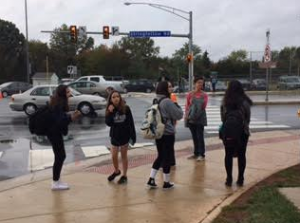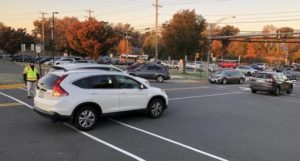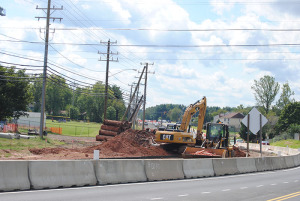Jaywalking poses danger to students

On Thursday, March 31, multiple students head home after school by crossing Stringfellow Road. When inconvenient, many choose to ignore the crossing signal or the crosswalk entirely, walking across the road directly in front of the Chantilly Regional Library entrance.
April 21, 2022
As the clock nears 8 a.m., the roads in front of the school become swarmed with cars and pedestrians alike. Cars and buses squeeze through the same entrance to the school, while thousands of students make their way to the main doors.
Stringfellow Road is notoriously congested during the morning rush. Despite the influx of vehicles, many students who drive or walk to school take the risk of crossing in the middle of the road to make it to class on time, to avoid the walk to the crosswalk or to bypass the time-consuming crossing signal.
“I do jaywalk, but I avoid the big rushes usually around 8 and 3 o’clock,” senior Meghana Bhave said. “If I’m leaving school late at like 4:30 or if it’s really early in the morning, then I can just walk across because there’s no one there. I park in the library, so it’s kind of annoying to walk the entire way, especially when it’s during those non-busy times when I know I can just walk across the street.”
A term originating in the U.S., jaywalking is loosely defined as when pedestrians walk across roads with no crosswalk or marked intersection or disobey a signal at a crosswalk. Jaywalking is a punishable offense in almost every city in the nation, since it can catch drivers off guard and interrupt flow of traffic. In Virginia, jaywalking can result in a $100 fine.
Students who actively choose to jaywalk may ignore the dangers or forget the high risk of getting into an accident. In early March, an email sent by Dr. Poole discussed two students who were victims of taking such a risk while attempting to cross Stringfellow Road. One of the students had been seriously injured and lost a part of their leg.
“[Jaywalking is] a pretty big problem that’s quickly growing day by day as more students begin to normalize it,” senior Shreshtha Peter Raj said. “I’ve seen the crossing guards constantly instruct students to use the designated crosswalk to cross the road for their own safety, yet students continue to jaywalk, not considering the dangerous consequences of doing so.”
Jaywalking is an issue prevalent not only among the student body, but also across the country. According to the National Center for Health Statistics, approximately 6,205 pedestrians died in traffic accidents on public roads in 2019. Of these pedestrian traffic deaths, 73% occurred on open roads, while 26% took place at intersections and crosswalks.
“I think people choose to jaywalk because they’re lazy,” school resource officer (SRO) James Maeng said. “To be honest, they just don’t want to walk that extra 10 or 20 feet or spend those extra 10 or 20 seconds because they like to take shortcuts and they don’t want to do the right thing, unfortunately. I also think they like the feeling of doing something they’re probably not supposed to be doing and getting away with it. Teenagers like the feel of adrenaline and the rush.”
In the state of Virginia, jaywalking was decriminalized on March 1, 2021 after former Gov. Ralph Northam passed House Bill 5058. As of now, it can only be charged as a secondary offense; in other words, pedestrians cannot solely be charged with jaywalking unless law enforcement can also charge them with a different crime.
Trends in racial profiling from police officers has encouraged governments to rescind jaywalking laws. A study taken in New York found that 90% of tickets for illegal or unsafe crossing were given to Black and Hispanic people, who only make up 55% of New York’s total population. Virginia Mercury reports that defenders of Bill 5058 believe they are taking small steps towards protecting Black and brown people from unjustifiable stops, such as loud mufflers and tinted windows, in addition to jaywalking. Black people made up 65% of people pulled over in traffic stops in Arlington, even though only 10-12% compose the entirety of the county’s population.
“I don’t think jaywalking should be illegal because it decreases the chances of people of color facing unjust police encounters,” Peter Raj said. “I think that we simply have to trust we make the right decision. Furthermore, jaywalking can be charged as a secondary offense, which I believe is a sufficient consequence for the ‘crime.’”
Despite the high numbers of students seen jaywalking to and from school grounds, the school is unable to fully enforce rules to deter students from doing so because they cannot exert power over a public highway. The crossing guard and SRO are both limited to giving verbal warnings to individuals who choose to not follow traffic laws.
“The school really can’t get involved because it’s more of a traffic or police matter,” Maeng said. “Us police officers [have] lost our power to stop you from jaywalking, but I stop students for their safety to make sure they’re not trying to harm themselves or anything like that. I’ll talk to them as they’re passing by me and educate them, but that’s all I can do.”
Maeng took the initiative to discuss the issue with the Virginia Department of Transportation (VDOT) when he first came to CHS. He suggested installing a crosswalk between the library and north exit of the school with flashing lights to alert oncoming cars.
“I called them multiple times, I talked to the VDOT Liaison police officer,” Maeng said. “They said it’s not something that they can do, but I have been trying. I have my hands tied behind my back.”
Although the school cannot punish students for jaywalking, there are other actions they can take for preventative measures.
“I think having a patrol where the entrance of the library is would be good because just having that one person at the crosswalk doesn’t really do anything, ” Bhave said. “If there’s one more person watching from that side, just having that extra security will result in a lot less people who jaywalk.”
Many individuals who are soon to be full-fledged adults believe it is important that smart decisions and habits are implemented at an early age. Ultimately, students can improve the safety of themselves and the people around them by reconsidering their actions on the road.
“You’re jaywalking at your own risk,” Maeng said.





